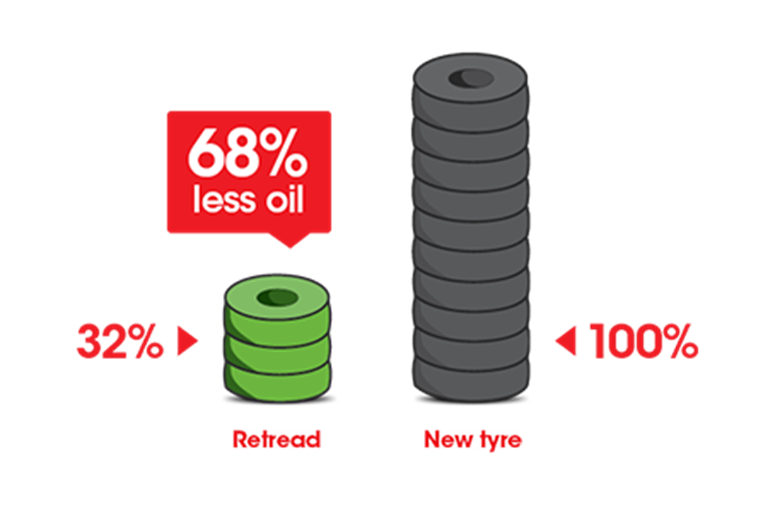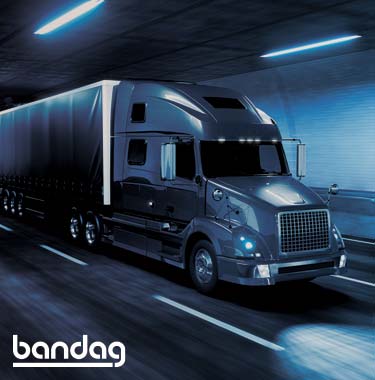Why choose retreads?
Today’s retreads make the most of new tyre technologies, helping savvy business owners enjoy new tyre performance at a fraction of the price. We bust a few myths about retreads, and show you why retreads make good business sense.
Retreading: our way to a better environment
When you choose Bandag retreads, you make a choice to contribute to the sustainability of our environment.
The Bandag retreading process makes it possible to efficiently recycle used tyres. Used tyres with good sidewalls can be rebuilt and put back to work again, and again.
A well-constructed truck or bus tyre can be retreaded two, three, or more times, depending on quality and condition. At the end, only one worn tyre casing is disposed of instead of many, yet another benefit of retreading tyres.
Reducing pollution
Retreading keeps each tyre on the road longer, reducing the number in landfill dumps.
Tyre dumps are a major source of pollution. Not only are they an eye-sore, they also attract vermin, hold water, and create a breeding ground for mosquitoes. They are also highly combustible and release toxic fumes and dense smoke into the atmosphere if ignited.
Conserving oil
It takes 80 litres of crude oil to produce one new truck tyre. It takes only 26 to turn a worn truck tyre into a fully functional retread. With approximately 350,000 retreads produced annually in New Zealand, retreads are already helping to save around 22 million litres of oil every year.Reducing energy use
Bandag’s unique, advanced, Cold Process Retreading technique uses less energy than conventional retread processes, and delivers a tyre with a wear performance similar to a new tyre.
While some retreads use a hot cap process with temperatures as high as 160 degrees, Bandag’s specially developed process uses a low 99 degrees to bond the tread to the case. This means, less energy is used to create each tyre.
Committed to our environment
Protecting our environment for future generations is also important to Bandag employees. Not only is the retreading process environmentally friendly but in November 2001 Bandag Manufacturing Pty Limited became accredited to ISO 14001 by a third party assessor.

Busting some common myths about retreads
Myth: They have inferior mileage.
Fact: A quality retread delivers mileage that is comparable, and sometimes even better, than new tyres. A tyre’s mileage is determined by a complex mix of tread compounding, tread weight, tread design and casing structure. New tyre mileage varies widely, and so does the mileage on retreads.
Myth: Worn out tread, worn out casing.
Fact: A casing can still be good long after your tread wears. A tyre casing doesn’t wear out like a tread does. So with proper maintenance you can expect to get multiple lives out of quality casings like those found on our tyres.
Myth: They just don’t perform.
Fact: Retreads perform so well, that they are used by top competitors at major on-track and off-road races. High quality retreads have been used by professional off-road racers for the toughest courses. They’ve run gruelling 24 hour races, and even helped a heavy truck reach over 240 kph at the Bonneville Salt Flats in the US.
Myth: They’re not safe.
Fact: Here’s a testament to safety: nearly every major airline trusts retreads. Retread technology has improved significantly, and today’s sophisticated retreads are superior to their predecessors. They’re so safe they’re used by vehicles as diverse as school bus fleets in the US to operational fighter jets. Fighter jet pilots count on retreads to survive the stress that jet tyres undergo during take-off, and keep them safe when landing.
Myth: They fail on hot days.
Fact: Retreads are no more likely to fail on hot days than any other tyre. Heat can damage all tyres, whether they’re new or retreads. The true culprit behind heat damage is often under-inflation, so proper inflation is vital no matter what kind of tyre you have.
Myth: They fall apart.
Fact: The bond securing the retread to the casing is extremely strong. In fact, it is so strong that it is more likely that the rubber around the bond will tear before the bond would break.
Myth: They’re not available for my vehicle.
Fact: Retreads can be produced for just about any heavy vehicle application. They are available in a huge range of sizes, widths, tread patterns and tread depths. No matter what vehicle you use, chances are there’s a retread to suit.
Myth: Retreads litter our roads.
Fact: Bandag’s state of the art shearography machines ensure that any casing defects are found and only suitable casings are retreaded. This means that retreaded tyres are unlikely to produce the kind of scrap rubber you usually see discarded on the road.
